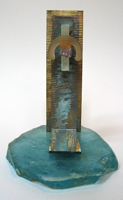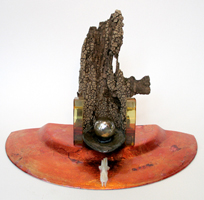Walking on the Wild Side
 ASHFORD – Take a walk with sculptor Lance Arnold and see the natural world full of new possibilities. Familiar natural settings that one might normally pass by without much notice, become areas of interest, places to pause, and sources of sculpture material. The natural world is rich in the simple beauty of the found object.
ASHFORD – Take a walk with sculptor Lance Arnold and see the natural world full of new possibilities. Familiar natural settings that one might normally pass by without much notice, become areas of interest, places to pause, and sources of sculpture material. The natural world is rich in the simple beauty of the found object.
Mr. Arnold composes many of his simple sculpture using the wood, stones, fish-bones, shells, and other natural materials found while walking in the natural and wild settings of New England. Beaches, woods, fields all provide quiet satisfaction in the commonplace bits and pieces one can find there. Who hasn’t picked up a white quartz pebble and admired the pure whiteness of it if only momentarily before tossing it aside. A sculptor, on the other hand, might go a step further to consider how that pebble might look nestled in strands of white birch bark or as part of an arrayed presentation of colored pebbles on a piece of drift wood.
Napatree Point, Rhode Island provides a long, high-energy beach. The winter storms tumble rocks into smooth symmetrical shapes. In addition to the snow-whiteness of quartz, are the business-suit- grey granites and the salmon-orange feldspars, all tumbled into round and oval and egg shapes. The wreck of a coal barge that sank many years ago off the point provides numerous iridescent pieces of blue- black coal when storms carry those pieces to the shore. Local fishermen clean their catch at the end of the day and leave the skeletal remains for the gulls and the crabs to future clean. They will turn into the beautiful, delicate bones, bleached to a fine whiteness in the sun. The sculptor may collect the bones and stones and coal to be later appreciated in their own right, separate from their natural settings and somehow enhanced.
black coal when storms carry those pieces to the shore. Local fishermen clean their catch at the end of the day and leave the skeletal remains for the gulls and the crabs to future clean. They will turn into the beautiful, delicate bones, bleached to a fine whiteness in the sun. The sculptor may collect the bones and stones and coal to be later appreciated in their own right, separate from their natural settings and somehow enhanced.
Snail shells attract many sculptors by their shape and color but also by their mathematical perfection. A simple white whelk becomes an object of renewed interest when centered on a flat stone or framed in bleached driftwood. A linear “parade” of snails is interesting as a sculpture because we are not used to seeing them in organized formation.
Hike into a hardwood forest to see the spring greening. Watch warblers as they hop about during their annual migrations. Leave the woodland trail and follow shadow lines into new areas rarely traveled. You might need to skirt the skeletal remains of fallen trees and branches as you hike along ‘round rocks and over streams. Weathering, over years of time, can erode and bleach oak into beautiful sinuous shapes. Small twigs and branches can later surround shells; curves of grey can cradle smooth pebbles in a way that enhances the perception of both.
Unfortunately, the natural world is also littered with the refuse and leftovers of our own care less activities. These, too, can be sources of surprising interest and, yes, even beauty.
 Corroded copper with its rich green patina is at least as beautiful as polished copper itself. Melted plastic can take interesting and unexpected shapes and melted and fused glass can scatter and play with the light. A sculptor could spend hours digging thru wave-tumbled dump material collecting metals and glass, rubber and plastic. Mr. Arnold has often spent an afternoon in an old dump finding old pieces of hose, pieces of tires, corroded metal, and chunks of glass…all to be arrayed across the floor of an overcrowded and cluttered studio. There, they join the piles of bones and shells and stones and wood. Pieces of basalt are collected from the side of I-91 where it cuts thru a rocky dike north of New Haven. Slabs of basalt are used for sculpture bases; chunks are part of the sculptures themselves. All of these found objects and collected pieces are assembled in try-and –try-again arrangements until it seems right…until it is pleasing…until it is done.
Corroded copper with its rich green patina is at least as beautiful as polished copper itself. Melted plastic can take interesting and unexpected shapes and melted and fused glass can scatter and play with the light. A sculptor could spend hours digging thru wave-tumbled dump material collecting metals and glass, rubber and plastic. Mr. Arnold has often spent an afternoon in an old dump finding old pieces of hose, pieces of tires, corroded metal, and chunks of glass…all to be arrayed across the floor of an overcrowded and cluttered studio. There, they join the piles of bones and shells and stones and wood. Pieces of basalt are collected from the side of I-91 where it cuts thru a rocky dike north of New Haven. Slabs of basalt are used for sculpture bases; chunks are part of the sculptures themselves. All of these found objects and collected pieces are assembled in try-and –try-again arrangements until it seems right…until it is pleasing…until it is done.
Mr. Arnold’s organic sculpture may be seen in his Lance Glass studio/gallery at 162 Amidon Rd., Ashford, CT06278. He can be reached at 860-487-0848 or larnold0848@charter.net.
